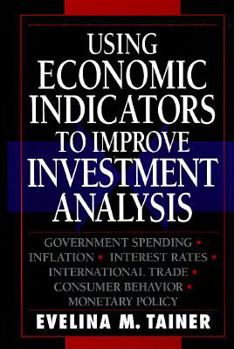Using Economic Indicators to Improve Investment Analysis
A comprehensive guide to the major economic indicators and their role in determining investment strategies. Each chapter describes one sector of the economy, which encompasses various economic... This description may be from another edition of this product.
Format:Hardcover
Language:English
ISBN:047158049X
ISBN13:9780471580492
Release Date:August 1993
Publisher:Wiley
Length:288 Pages
Weight:1.25 lbs.
Dimensions:1.0" x 6.3" x 9.3"
Customer Reviews
3 ratings
A Useful Book
Published by Thriftbooks.com User , 16 years ago
This is a good book on how the different sectors of the economy affect the overal economy and how they move relative to the business cycle. The book explains how these sectors affect the business cycle and how they can be used to assess the state of the economy and forcast the different stages of the business cycle. The book can be a very good complement for a textbook on macroeconomics or business cycles. It is much more practical than most macroeconomics books. The book describes many important economic indicators and how markets react to each one of them. However, the book does not put these economic indicators (and the dynamics of the different sectors) into a framework or a plan that the investor can use to make investment decisions. The last chapter of the book makes an attempt at doing that, but, in my opinion, it is not enough. I also recommend "The Investor's Guide to Active Asset Allocation" by Martin Pring which does a great job in explaining the business cycle and how to factor it into your investment decisions.
Fairly Good Introduction
Published by Thriftbooks.com User , 17 years ago
From my point of view, this book consists of three parts. Part one, that is, Chapters 1-6, devoted to national accounts and their indicators. Part two, that is, Chapters 7-9, devoted to inflation and inflation related labor and production indicators, and finally part three, Chapters 10-11, is devoted to the central bank and treasury systems. The investment analysis part of this book seems to be the market reaction parts mentioned at the end of each section. Yet they seem to me a little too simplistic for the real world. In the real world, we mostly observe growth cycles rather than business cycles. In other words, business cycle recessions rather than growth cycle recessions are depicted in market reaction parts in this book. Nevertheless this is a good streetwise ECON 101 book. As a final note; although not updated, its second edition seems to me better.
Bringing theory to life - an easy read
Published by Thriftbooks.com User , 22 years ago
This is not only an excellent reference source, but also a very interesting book. People who are not experts in the fields of economics or finance will have no problem grasping the concepts. I keep it in the office for reference and from time to time pick it up to read up on different topics. I've been impressed with Tainer's ability to make these concepts so easy to understand. Her "Did you know? and Market Reaction" sections are also very interesting and provide an inside view as to how government policymakers and financial marketmakers shape the economy in ways that are very relevant to the average consumer. I recommend this book to anyone who is looking for a good reference book or wants to complement his studies in this field. I think that college students can benefit a great deal from it. For those of you who watch CNBC or CNNfn constantly, you stand to benefit the most from a book like this as it will not only teach you the cause and effect of important economic indicators that are put on the screen on a daily basis, but what's more important, the reasons why they impact the economy and the markets the way they do.





